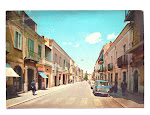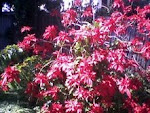-
This is how the castle of Monteserico looks today after being restored, there is a lot more to see, and I will show you in our next post/s.
-
The Normans' Monteserico castle
This is some history of Genzano Menteserico castle and the
Normans as I understand it.
Let me explain first that what I am writing
here is a personal story, this story somehow bridges history itself and
explains things that most of us did not know before, so, let me tell you that I am adding more and more things as I learn them, most of them of course come from the Internet; you see even though I come from this town of Genzano, there are a lot of things that I did not know, when I left the town, so, this first post is more or less what I knew in the beginning, plus a few personal happenings.
Since I came to Australia I have worked in
the building industry where I met this Frenchmen called Luis, we worked with
the same firm for a few years and most times I and Luis worked together, so we
knew each other well. Luis came to Australia when France left Algeria and the
army of Algeria was dismantled so to speak, Luis was a captain in the army, so
he had learned about many army things including army history. Anyhow let me
come to the point of why Luis knowledge is important here.
One day I was looking on the TV at the Tour
of France, this stage was run in Normandy, so while I was looking at the
country side I saw this castle in the background, which I could have sworn that
it was exactly the same as the castle that I had been seeing thousands of times
from my farm in southern Italy. So next time when I met Luis I asked him about
it and surprise, surprise no sooner I mentioned the castle of Monteserico that
he knew all about it, so he explained to me.
The Normans have only built two castles one
in France and another in southern Italy, and from this castle of Monteserico
they would dominate all their conquests of southern Italy. So here is the proof
that Luis gave me, which is that the castle of Monteserico has been built from
the Normans.
Now I have to say that even with Luis
explanation about the castle of Monteserico, I am not sure if he was right to
assume that the Normans built this castle, Luis story only shows us that this
castle of Monteserico has been used from the Normans, because there are other
stories about its origin; in fact there is even a story that this castle was
built as a monastery in the beginning and then went through several changes and
uses. It was built above a cave where indigenous people used to live a very
long time ago.
Anyhow the fact remains that the Norman
really had possessed the castle of Monteserico, because history shows us that
in the X or XI century there indeed was a great battle around this castle won
by the Norman, and therefore the Normans used this castle to dominate their
conquests in southern Italy.
To see more click on link below
Now let us go back to talk about the modern
Genzano; or should I say the Era when they started to build the modern Genzano
as it exists today, we guess that it could have been the twelfth or the
thirteen century, and this is what was happening then in the new would be
Genzano: You see in this castle of Monteserico that the Norman had used as we
have written above, which is about fifteen kilometres away from Genzano and
situated East-South-East of Genzano. This is an old castle built perhaps from
the Norman’s or somebody else during or after the fall of the Roman Empire when
they overrun Italy; to this day no other building has been built near this
castle except a small chapel. Anyhow when the Norman domination came to an end
somehow later on, it was owned from other important people and one day there
was this Spanish Princes called Aquilina Sancia, who later on would become the
new founder of Genzano town.
--------------------------------------------
Aquilina Sancia queen of Monteserico
This is how the modern Genzano came into being;
The story and folklore of Genzano says that it was Aquilina Sancia, who
happened to own the castle of Monteserico at the time when Genzano needed help
to restart again helped the town restart.
Aquilina Sancia some people say is a Spanish Princes, other people say
that this Aquilina Sancia had to do something with the Sforza family and she
was a queen. But, anyhow this castle of Monteserico that we have been talking
about above, at that time happened to be owned by a rich and powerful family
and queen named ‘Aquilina Sancia’ who most likely used this castle as a resort
only; because this castle is only a small square building, it is a solid coarse
fortress built on a treeless roundish hill with extensive views of the
countryside,
Which at that time were mostly grazing lands, with sheep shepherds and
some other livestock, and perhaps some wheat farming in a small way? So it
would have been ideal for a queen to get away from it all, and still feel safe
in that small fortress. (Nowadays that grazing land which is several thousand
of Hectares is top arable land, used mainly to grow durum wheat, and is one of
the best lands for this purpose.)
Anyhow, this Aquilina Sancia Queen of Monteserico, while she was living
in this castle, she liked very much to travel in her stagecoach or on horseback
between Monteserico castle and then would be new Genzano of those times,
Genzano was then only a small town but she liked it, so she helped it to become
it a real town. The folklore story goes that she used a secret tunnel, or a
secret way between these two places, as no one could understand how she could
manage to travel without being seen, because, while she was thought to be in
Monteserico castle, suddenly she would appear in Genzano without seeing her
coming or going. She must have been very rich because it is said that, she hid
a treasure that to these days has not been found, and the most valuable items
consist of a ‘Gold Mother Hen with Chicks’ which has been hidden somewhere in
Monte-Serico castle or in the secret tunnels or there about.
To me all those hidden riches and the large secret tunnel that she could
run in with her stagecoach is all folklore fantasy. But perhaps there was a
small tunnel in Monteserico castle and also one in Genzano small castle that
she turned into a monastery, this could allow her to come and go without being
seen. In theory it could have been possible that she could drive her stagecoach
in one of the caves in the chasm bellow the monastery, and from there through a
supposed small tunnel find the way into the monastery above. Therefore, there
may be some truth about the tunnel story, even if the rest is all folklore
fantasy.
-----------------------------
How the modern Genzano came into being
Because this queen liked Genzano, she built a monastery where the old
first building was, and because of this monastery the people in the country
started moving back in the new town of Genzano, this is how the modern town of
Genzano was found and she was loved from building this monastery. It is said
that in her old age she moved in this monastery and died there.
We could only imagine that the people of those times had an exaggerated
benevolent fantasy for this Queen, because of the good turn she gave to the
folks of the new Genzano of those days; since one can say that she was the real
founder of the new Genzano, because she financially built the first monastery
and a church in Genzano called ‘L’Annunziata’ together with a rich monastery
for the order of ‘The Sacred Nuns’ which has lasted up to 1905 the early part
of the twentieth century. (Nowadays the church and the monastery have been
restored for heritage values) But as it happened in those times, the building
of the church and the monastery brought a change of life to those people that
were still living in the caves of the chasm and in the fields, because; after
that church building they really started to build more houses nearby their church
and monastery, and slowly Genzano became a real town.
The reason why most of them left the caves and came to live into town is
not clear, the reasons that they left the houses in the fields it was because
there was malaria associated with this sort of living. Of course there are
other reasons to leave the caves, and it could have been for reasons of safety,
or perhaps they had become too many and so had overgrown the caves.
But in moving to town they set a new way of life that would split the
community in two, because some of the man folks had to stay put in the chasms
and in the fields to look after their flocks, and whatever else they had to do
in order to earn a living, either in the caves or in the working fields; while
the rest of the community would live in town. So from that time onward there
were town’s people and country people belonging to the same town, which is a
typical way of life of the rural towns of Southern Italy. Of this typical way
of life I intend to talk about in more details, as it has affected my own way
of life adversely during my younger days.
But now let me go back to the main story: After most of the cave people
moved to live into town, the caves became partly empty. But by now the
inhabitant of the caves new that those caves, which in the beginning had been
excavated for survival could still be put to good use, because they would be
ideal to make wine in them, since they have a constant cool temperature
throughout the year, therefore the wine would keep well for a long time, and
since then they have made their wines in those caves. Looking at the caves when
I was young, the front of the caves have been closed in with a masonry wall,
which has a door opening in the centre with a segmental arch above. The doors
openings are fitted with a double hung oaken timber doors, which are very
solid, even though they have air vent panels built in them, in order to have
some ventilation in the cave as there is no other opening in the cave.
Now as I was saying before, that you would be amazed to see when they
make their wines, and indeed it is an interesting thing to see, if you happen
to be there at the time when they harvest their grapes and they make their
wines, as the whole place, which is only a chasm with so many caves, but at
that time the chasm becomes alive in its own archaic ways.
Before we talk about the chasm I am going to write a bit more about this
castle of Monteserico, I think I have said enough in this hub, so I say see you
in my next article.
-------------------------------------------
Genzano it story
The Normans' castle of Monteserico
IS GOING TO BE CONTINUED;
Next time with, another post about the castle
-------------------------------------------
Some useful links
Some hub links




















